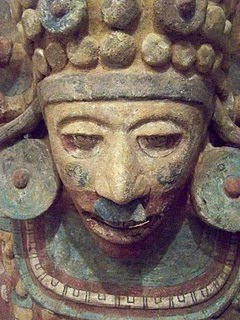
Lake Texcoco was the home of the capital city of the Aztecs-Tenochtitlan. Built on a lake with canals for streets, the Spanish called this beautiful city the "Venice of the Americas."

The Aztec dike protecting Tenochtitlan from floods is visible on the lower half of this Spanish map of the city.

As with all cultures, food was a daily necessity. Many of the foods the Aztecs ate have become common place in our world today, corn (maize), chili, tamales, tortillas and salsa were all introduced to the Europeans through contact with the Aztec Empire.

A favorite drink of the Aztec elite was chocolate.
This scene is from the Nuttall Codex showing where a cup of foaming chocolate is exchanged at a marriage. The Aztec version of drinking chocolate was not sweet, it was spiced with hot peppers. After the conquest, the Spanish were the first to add sugar to the drink.

Aztec weapons were made of stone and wood. The Aztec Maquahuitl warclub/sword was a fearsome weapon used obsidian stone blades. The blades were razor sharp but virtually useless against the steel armor and weapons of the Spanish.

Education was mandatory for all Aztec children; great store was put into the concept that knowledge strengthened the society.

Ullamaliztli-The main Ball Game of the Aztecs. On important religious occasions the losing team was often sacrificed to the gods.

The full Ullamaliztli ball court with the hoops in opposite walls. Similar to soccer, the ball could not be touched with the hands. The object was to have the ball go through the small stone hoop at the center of either wall.

Human sacrifice was seen as necessary to feed the gods. The Aztecs believed that without the most precious thing on earth, human life, the gods would die and the World would end. The numbers of lives given to the gods is unknown, some sources say hundreds a year, some say thousands and others estimate tens of thousands per year. Nothing convinced the Spanish that the Aztecs were barbarian more than this aspect of the culture of the Mexica.

Jaguar brazier used to burn the hearts of sacrificial victims so to speed their way to the gods.




I'd like to point out that the Maquahuitl was in fact one of the more fearsome weapons wielded by the Aztec army. One particular account by a mounted Spanish soldier, spoke of this weapon being brought down upon their horse's neck, and cleaved it entirely from it's body, hanging by only a piece of skin.
ReplyDeleteIt is also incorrect that all Spanish soldiers had steel armour, as this piece of equipment was expensive and entirely unnecessary for foot soldiers. Here is a good comparison between equipment of a Spanish footsoldiers and an Aztec Eagle Knight; http://lajhsslab.com/latin2/images/conquis.jpg
In fact, the Aztec Atl-atl has been recorded as penetrating steel armour and passing entirely through a soldiers body, at a range in excess of 100 yards.
Perhaps the real reason the Spanish were so successful, does not in fact lie with their technology, but the numbers of native allies they made, such as the estimated 80,000-200,000 Tlaxcalan warriors who were present at the Fall of Tenochtitlan. The Aztec defense had an estimated 300,000 (including war canoes to defend the causeways)